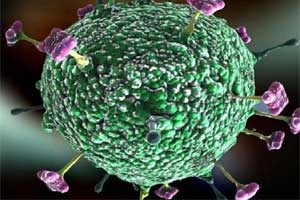- Home
- Editorial
- News
- Practice Guidelines
- Anesthesiology Guidelines
- Cancer Guidelines
- Cardiac Sciences Guidelines
- Critical Care Guidelines
- Dentistry Guidelines
- Dermatology Guidelines
- Diabetes and Endo Guidelines
- Diagnostics Guidelines
- ENT Guidelines
- Featured Practice Guidelines
- Gastroenterology Guidelines
- Geriatrics Guidelines
- Medicine Guidelines
- Nephrology Guidelines
- Neurosciences Guidelines
- Obs and Gynae Guidelines
- Ophthalmology Guidelines
- Orthopaedics Guidelines
- Paediatrics Guidelines
- Psychiatry Guidelines
- Pulmonology Guidelines
- Radiology Guidelines
- Surgery Guidelines
- Urology Guidelines
Indian scientists find new drug targets to treat Nipah virus

Nipah virus infections have killed 72–86% of the infected individuals in Bangladesh and India. The infections are spread via bodily secretions of bats, pigs and other infected individuals. It has a high mortality rate and there are no licensed drugs against it.
Now, researchers have used the information on the structure of the Nipah virus to identified 150 possible inhibitors of the virus. The results are published in PLOS Neglected Tropical Diseases.
Nipah virus disease was first identified in 1998, there are no approved drugs or vaccines against it. Though the overall number of fatalities linked with each individual outbreak has never been more than 105, the disease poses a deadly threat and could become pandemic.
In the new work, M.S. Madhusudhan and colleagues at the Indian Institute of Science Education and Research Pune first made three-dimension models of the 9 Nipah virus proteins. Then, they used these models to design inhibitory molecules to block the proteins' activity. Finally, the team assessed how effective the proposed inhibitors would be against 15 different strains of the virus -- 3 Bangladeshi, 7 Malaysian and 5 Indian strains.
The researchers computationally identified 4 putative peptides inhibitors and 146 small molecule inhibitors against Nipah virus proteins. 13 of their proposed inhibitors were short-listed as the most promising based on their binding strength, stability, and effectiveness against multiple strains of Nipah virus.
"We conclude that it is highly likely that the proposed inhibitors would be potent against all strains of the virus Nipah and other related zoonotic viruses that pose a serious epidemic threat," the researchers say. "Computational approaches can help identify and design inhibitors that could be rapidly tested or even deployed."
In order to counter the threat of drug resistance, the researchers have analysed the sequences of the viral strains from different outbreaks, to check whether they would be sensitive to the binding of the proposed inhibitors
For more details click on the link: DOI: 10.1371/journal.pntd.0007419
Next Story
NO DATA FOUND

Disclaimer: This site is primarily intended for healthcare professionals. Any content/information on this website does not replace the advice of medical and/or health professionals and should not be construed as medical/diagnostic advice/endorsement or prescription. Use of this site is subject to our terms of use, privacy policy, advertisement policy. © 2020 Minerva Medical Treatment Pvt Ltd